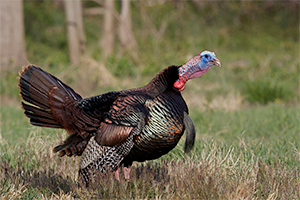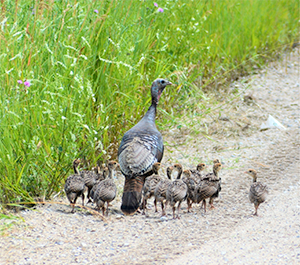Home → Fish & Wildlife → Wildlife → Species Information → Birds → Upland Game Birds → Wild Turkey
Wild Turkey

On this page:
- Habitat
- Diet
- Distinctive Characteristics
- Nocturnal/Diurnal
- Seasonal Changes
- Reproductive & Family Structure
- Survival & Threats
- Management & Conservation
- Wild Turkey Hunting Season History
- Prevent or Resolve Conflicts
Turkeys are one of Maine’s greatest success stories. A once extirpated species from the state, MDIFW successfully transplanted a small group of turkeys to southern Maine.
Habitat
Eastern wild turkeys generally require large tracts of mature hardwoods (especially nut producing species such as oak and beech) interspersed with stands of mature pine. They also require grassy openings and hay and pasture lands for raising their young.
Diet
Turkeys feed on a wide variety of animal and plant materials such as insects, greens, fruits, berries, seeds, grains, and nuts. During winter, turkeys feed on bayberry fruits, sensitive fern spore heads, burdock seeds, and other vegetation around spring-fed brooks and on bare edges of fields. Turkeys also utilize food sources from humans such as bird feeders and corn silage from dairy farms, especially in winter months when weather conditions are more extreme and natural food sources are limited.
Distinctive Characteristics
The wild turkey is North America's largest upland game bird. Average adult hens weigh between 8 - 12 lb. and adult toms between 10 - 20 lb., but a large tom can weigh in excess of 25 lb. Toms sport beards which are bristle-like feathers that protrude from the chest and can grow to a length of more than 12 inches on older toms. Beards may be present on about 10% of the hens; however, they are thinner and shorter than those of adult males. Heads of gobblers (adult toms) are generally bare and blue with a hint of pink and red, but colors can change with the mood of the tom. During mating season, the gobbler's crown swells and turns white and its wattles become large and bright red. Heads of hens are somewhat feathered with smaller, darker feathers extending up from the back of the neck. Legs of toms are longer than the hens and are equipped with spurs.
Footprints of toms can exceed 6 inches, whereas a hen's footprint rarely exceed 4+ inches. The breast feathers of hens are buff or brown tipped; the tom's are tipped with a sharp band of black. Wild turkey plumage is more iridescent than domestic turkeys, and their tail feathers are tipped with brown rather than the white found on domestics. Wild turkeys have keen eyesight, acute hearing, and are agile fliers, although they often walk or run from danger.
Nocturnal/Diurnal
Turkeys are active during the day (diurnal), and roost in trees at night (nocturnal).
Seasonal Changes
Turkeys are social and form groups (called bands) during the winter. Each band may defend a territory against other bands.
Reproduction & Family Structure

Wild turkeys in Maine breed during April and May. Dominant toms do most of the breeding. Through elaborate strutting and gobbling, they try to attract and mate with as many hens as they can, which may be as many as 12 or more. After breeding, hens confine themselves to nesting. They construct nests in shallow depressions on the ground at the base of a tree or stump, under a tangle of brush, or in dense herbaceous cover. One egg is laid each day for up to ten to twelve days. Eggs are incubated by the hen from 26 to 28 days before hatching. If left unguarded, eggs are vulnerable to predators such as crows, skunks, raccoons, and red squirrels, and incubating hens can fall prey to dogs, coyotes, foxes, raccoons, bobcats, fisher, and great horned owls.
Poults (young turkeys) usually leave the nest the day they are hatched. Hens and their broods frequent field edges and forest openings in search of insects, which provide the protein poults need for rapid growth during their early development. After five to six weeks of age, young turkeys begin roosting in trees, thus greatly reducing their vulnerability to predators.
Family Structure
Hens and their poults join other poults and hens to form flocks of 6 - 25 birds (occasionally up to 50 birds) during late summer, fall, and winter. Adult toms generally remain loners, but small groups of two to five toms of mixed ages are commonly seen throughout the year. Feeding turkeys can cover several miles in a day.
Survival & Threats
Mortality is greatest and most variable in the early stages of life with a life expectancy of between three and four years, often succumbing to predators. Once wild turkeys reach adulthood, they may live as long as 10 years.
Disease can be another cause of mortality. While birds often survive diseases such as avian pox, sometimes severe cases can lead to lesions that may cause blindness. Learn more about common wildlife diseases.
Management and Conservation
Historical Management and Population Trends - Historically, wild turkeys existed in significant numbers in York and Cumberland Counties, and perhaps in lower numbers eastward to Hancock County. From the time of settlement until 1880, agricultural practices intensified until farmland comprised about 90% of York and Cumberland counties. The reduction in forest land and unrestricted hunting are believed to be the two most important factors leading to the extirpation of native wild turkeys in Maine in the early 1800s. Since 1880, many farms have been abandoned and the land has reverted back to forest. By 1970, only 15% of York and Cumberland Counties remained farmland. This reversion of thousands of acres of farmland to wooded habitat greatly enhanced prospects for reestablishing turkeys into their former range.
Attempts to reintroduce turkeys to Maine began in 1942 when the Department of Inland Fisheries and Game (now the Department of Inland Fisheries and Wildlife) released 24 birds on Swan Island, in Sagadahoc County. In the 1960s, fish and game clubs in Bangor and Windham made similar attempts to reestablish turkeys in their areas using imported birds raised from part wild and part game-farm stocks. None of these attempts succeeded in establishing populations of wild birds. In 1977 and 1978, MDIFW obtained 41 Wild Turkeys from Vermont and released them in the towns of York and Eliot. In Spring 1982, 33 turkeys were trapped from the growing York County population and released in Waldo County. In the winter of 1984, 19 birds were captured in York County and released in Hancock County, but poaching was believed to be the demise of these birds. During the winters of 1987 and 1988, 70 Wild Turkeys were obtained from Connecticut to augment Maine's growing turkey population.
Current Distribution
Current population data collection consists of mandatory registration of harvested wild turkeys during both the spring and the fall wild turkey hunting seasons. Along with this harvest registration information the Department used harvest rate estimates from a 2018 to 2020 banding study to generate a population estimate of a spring population of 70,000 wild turkeys. It’s important to note that this is an estimate of wild turkeys prior to recruitment of new turkeys into the population from current year reproduction. The number of turkeys on the landscape in the fall is much higher and can fluctuate based on weather conditions and predator numbers. Today, wild turkeys can be found in all Maine counties. Snow depth is believed to be the major factor limiting the distribution of turkeys in Maine.
Current Management Goals and Objectives for 2017-2027:
Goal #1: Maintain a healthy, sustainable turkey population that provides opportunities for hunting and viewing, while also allowing turkeys to continue expanding into portions of northern, eastern, and western Maine
- Develop and implement reliable methods to monitor wild turkey population trends
- Improve quality and availability of wild turkey harvest data
- In WMDs 15-17, 20-26 and 28, stabilize wild turkey populations below biological carrying capacity and at socially acceptable levels.
- Increase the size and distribution of turkey populations in WMDs 1-14, 18, 19, and 27.
Goal #2: Ensure public satisfaction with the turkey population
- Improve the Department’s ability to track wild turkey conflicts.
- Provide information to landowners on methods to reduce wild turkey conflicts.
- Increase hunter effort and opportunity in areas with high levels of landowner conflicts to reduce local populations.
- Maintain the quality of the turkey spring hunt as measured by safety and levels of hunter interference.
Goal #3: Increase the recreational value of the wild turkey resource by promoting participation in wild turkey hunting
- Promote wild turkey hunting to Maine residents and non-residents.
- Develop tools to determine the current participation and interest of youth hunters.
- Increase the public’s awareness of the value of wild turkeys and the use of hunting as a population management tool.
Goal #4: Provide education to Maine residents (including hunters) on turkey biological, ecology, and management
- Increase the public’s knowledge about wild turkey seasonal behavioral changes, impacts on forest regeneration, and interactions with other species.
- Maintain or increase the 2016 levels of satisfaction and support for wild turkey management.
Wild Turkey Hunting Season History
- Prior to 1955: No statutes or regulations regarding wild turkeys in Maine.
- 1955 - 1959: Statute passed establishing no open season on turkey until October 13, 1960, when there would be an open season on turkey for 15 days (not including Sundays) of either sex with a bag limit and possession limit of 1 turkey.
- 1960 - 1971: Statute repealed; again, no statute regarding wild turkeys.
- 1972 - 1984: Wild turkey listed as an upland game species over which Commissioner was given regulatory authority. Regulations established no open season for hunting or trapping of turkey.
- 1985: Commissioner given authority to establish a spring wild turkey hunting season.
- 1986: First spring hunting season in Maine from 8 May to 24 May in York County.
- 1992: Hunting zone expanded to include a large portion of Cumberland County.
- 1996: Major expansion of hunting zone
- 2002: First Fall Season open in a limited number Wildlife Management Districts
- 2005: Elimination of Turkey Permit Lottery and open to all hunters
- 2014: Open to all day spring hunting; previously hunting ended at noontime.
- 2015: All Wildlife Management Districts open to spring hunting
Living with Wildlife
How to Prevent or Resolve Conflicts with Wild Turkey
Turkeys provide wildlife lovers an easy and safe opportunity for viewing wildlife, and they are a treasured game bird by hunters. In addition to their social value, turkeys exist as both predator and prey during their lifecycle, enhancing the biodiversity of ecosystems wherever they inhabit. As poults (young turkeys), turkeys consume various bugs and pests, and are prey for a variety of wildlife. The rich protein and fat of turkey eggs in the spring, when other food sources are not yet available, provide a vital food option to numerous wildlife species throughout the state.
If you do not want turkeys to visit your backyard, do not feed turkeys (or other birds) that provides an attractant. If problems are already happening, hazing turkeys is usually a good way to prevent them from settling into an area. Chasing them while waving your arms, clapping your hands, and yelling at them should assist in the flock fleeing. Loud noises, including a loud dog bark, can help.
Learn more about how to prevent or resolve conflicts with turkeys